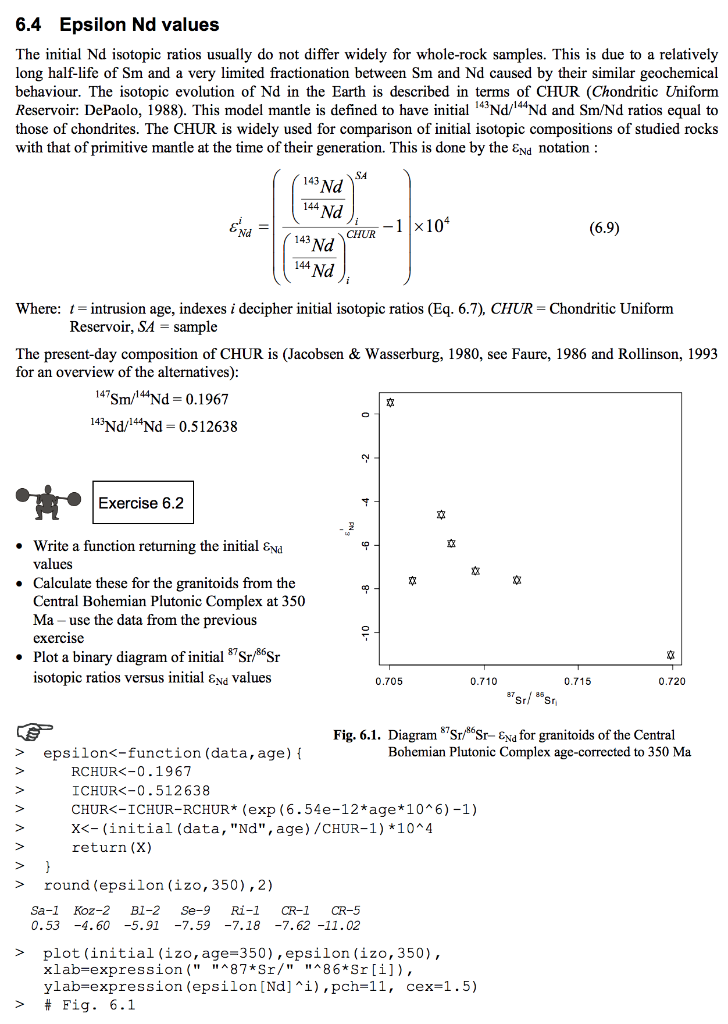Please show how to convert this code to excel file.

6.4 Epsilon Nd values The initial Nd isotopic ratios usually do not differ widely for whole-rock samples. This is due to a relatively long half-life of Sm and a very limited fractionation between Sm and Nd caused by their similar geochemical behaviour. The isotopic evolution of Nd in the Earth is described in terms of CHUR (Chondritic Uniform Reservoir: DePaolo, 1988). This model mantle is defined to have initial 14 Nd/144Nd and Sm/Nd ratios equal to those of chondrites. The CHUR is widely used for comparison of initial isotopic compositions of studied rocks with that of primitive mantle at the time of their generation. This is done by the end notation : 143 Nd) 144 Nd ENd143 Nd (6.9) 143 NA CHUR-1/4104 144 Nd i Where: 1= intrusion age, indexes i decipher initial isotopic ratios (Eq. 6.7), CHUR = Chondritic Uniform Reservoir, SA = sample The present-day composition of CHUR is (Jacobsen & Wasserburg, 1980, see Faure, 1986 and Rollinson, 1993 for an overview of the alternatives): 147Sm/14Nd=0.1967 143Nd/144Nd=0.512638 0 -2 Exercise 6.2 -4 -6 -8 Write a function returning the initial Ena values Calculate these for the granitoids from the Central Bohemian Plutonic Complex at 350 Ma - use the data from the previous exercise Plot a binary diagram of initial 87Sr/86 Sr isotopic ratios versus initial End Values -10 0.705 0.710 0.715 0.720 sr/sr > V V Fig. 6.1. Diagram Sr/Sr-End for granitoids of the Central epsilon plot (initial (izo, age=350), epsilon (izo, 350), xlab=expression (" "^87*Sr/" "^86*Sr[i]), ylab=expression (epsilon [Nd] ^i),pch=11, cex=1.5) # Fig. 6.1 > 6.4 Epsilon Nd values The initial Nd isotopic ratios usually do not differ widely for whole-rock samples. This is due to a relatively long half-life of Sm and a very limited fractionation between Sm and Nd caused by their similar geochemical behaviour. The isotopic evolution of Nd in the Earth is described in terms of CHUR (Chondritic Uniform Reservoir: DePaolo, 1988). This model mantle is defined to have initial 14 Nd/144Nd and Sm/Nd ratios equal to those of chondrites. The CHUR is widely used for comparison of initial isotopic compositions of studied rocks with that of primitive mantle at the time of their generation. This is done by the end notation : 143 Nd) 144 Nd ENd143 Nd (6.9) 143 NA CHUR-1/4104 144 Nd i Where: 1= intrusion age, indexes i decipher initial isotopic ratios (Eq. 6.7), CHUR = Chondritic Uniform Reservoir, SA = sample The present-day composition of CHUR is (Jacobsen & Wasserburg, 1980, see Faure, 1986 and Rollinson, 1993 for an overview of the alternatives): 147Sm/14Nd=0.1967 143Nd/144Nd=0.512638 0 -2 Exercise 6.2 -4 -6 -8 Write a function returning the initial Ena values Calculate these for the granitoids from the Central Bohemian Plutonic Complex at 350 Ma - use the data from the previous exercise Plot a binary diagram of initial 87Sr/86 Sr isotopic ratios versus initial End Values -10 0.705 0.710 0.715 0.720 sr/sr > V V Fig. 6.1. Diagram Sr/Sr-End for granitoids of the Central epsilon plot (initial (izo, age=350), epsilon (izo, 350), xlab=expression (" "^87*Sr/" "^86*Sr[i]), ylab=expression (epsilon [Nd] ^i),pch=11, cex=1.5) # Fig. 6.1 >







